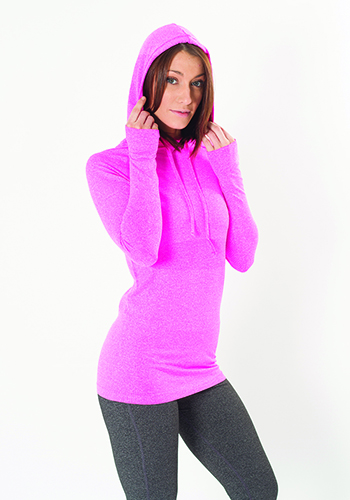January 15, 2016
Whether for sports, activewear or corporate apparel, performancewear represents tremendous profitability in a less-contested market space.
As the apparel and the synthetic fibers from which they are made are steadily developing and rising in popularity and complexity, there is no standing still in a market that is exploding. Terms like “SPF ratings,” “moisture wicking,” “antimicrobial” and “wrinkle free” should easily be recognized by anyone buying or selling performancewear. To pause in deciding whether to jump into the game is the equivalent of moving backward.
Understanding the unique properties of performancewear today, as well as its challenges and innovations, will help you become an expert and develop a winning presentation for the well-educated consumer of today.
PERFORMANCE AESTHETICS
The term “athleisure” is not merely a trend, but a lifestyle shift, as fashion and function collide.
Professionals want to dress in a way that allows them to be comfortable both during and after work. Today, Millenials make up more than 50% of the workforce, and they want to look and stay cool, and experience not only work/life balance, but also convenience in work/life integration. This includes what they wear.
Consequently, fashion and trends are driven by context. A notable rise in the sales of heather fabrics raises their perception over basic colors and delivers a look fit for the office. Textures such as laser etching details or heat-applied treatments are on the rise and cue interest on neutral shades such as charcoal and black wearables. The inclusion of color-blocked details, and contrast-color trims and accents, add a sporty pop while maintaining professional appeal.
Interesting plackets for ladies’ polos drive differentiation from a bland unisex style. This creates an opportunity for decorators to showcase a higher-end option versus a traditional cotton polo.
For the younger Generation Z market, patterns reign supreme, courtesy of technology such as dye sublimation. Whether on allover-printed performance tees for boys or sublimated tights for girls, full color that delivers interest is everywhere. Adaptations of camouflage, hex patterns, repetitive shapes, hombres or designs that deliver a look of texture, such as lace, all are on trend. Tapered performance chinos and fleece that fit close at the ankle still are growing in popularity. And yoga pants paired with oversized shirts are a staple.
While browsing blank apparel wholesalers’ catalogs, look to merchandise the latest looks. Complete mannequin displays or photos of garments on models on your website validate your position as a performance apparel expert. Investing time and effort can yield an increase in sales and a protection of profit.
FOCUS ON BELIEF
Functional fabrics drive belief. After all, performance is the apparel’s namesake. The new benefits of performance are much aligned with the old, except in sports, where targeted muscle performance is the intended result. This trend includes engineered apparel that features compression zones mapped to specific muscle groups. In general, compression is geared to reduce muscle movement, increase power and enhance recovery. With a targeted approach, core muscle groups get exactly what they need when they need it.
Additionally, lighter-weight fabric always is in demand. Apparel manufacturers are developing advancements to reduce fabric weight for speed and feel. Technologies such as advanced circular knitting continue to advance the compression segment, providing the possibility of seam-free construction to prevent chaffing, improve longevity and deliver the feel of “second skin” without bulk.
Look for little things that can win a sale. Vented areas to increase breathability and reduce weight are important. Maintained peripheral view through vented hoods; mobile-friendly pockets that venture into wearable technology; and thumb holes at the cuffs can add to a piece’s overall value.
Belief is confirmed with understanding. Think about why you should offer certain pieces to your clients and help them understand your recommendations.
DECORATION OPTIONS
In virtually every market, people want customization. Decorating performancewear without regard for the fabric is the downfall of most shops, so having a printing philosophy for this kind of fabric is critical to success.
First, approach performancewear decoration with intent to maintain the garment’s performance. Choose a lightweight print style and use tact when choosing logo size, style and placement. One of the biggest fails with performancewear is decorating it with a heavyweight print that compromises the goals of the garment.
Next, with a solid understanding of the fabric blend, select print technologies that adhere without requiring high heat that would scorch the garment. Heat printing has come a long way in this regard, and low-temperature adhesives with stretch capabilities headline the most popular technologies for printing performance fabrics of all compositions and colors.
Whether it’s screen-printed transfers, print-and-cut digital transfers or heat-transfer film, there are many options for a decorator. However, using the same transfer applied at 330˚F-380˚F will not yield positive results. Look for products that apply at 280˚F or less.
Sublimation for performancewear also is a mainstay. At the factory level, cut-and-sew sublimation allows for fully printed fabrics, making virtually anything possible, but sublimation chemistry still requires a light-colored garment comprised of high polyester content with sublimation inks activating at approximately 375˚F.
As long as a decorator understands these factors, he can seek sublimation-specific blanks for post-production printing of assembled garments. Wide-format or desktop-printed graphics allow a customization option with no feel.
Josh Ellsworth is general manager for Stahls’ CADCUTdirect.com. For more information or to comment on this article, email Josh at josh@cadcutdirect.com or visit his website at joshellsworth.com.
More Build Your Business
March 29, 2024
If you’re a print shop owner who’s curious about the benefits of sustainable practices, now is a great time to start on the path toward a greener, cleaner and more profitable future for your decorated-apparel business.
FULL STORY
March 26, 2024
Team sports took a back seat during the pandemic, and as expected, the athletic and teamwear decorated-apparel market saw a major downturn in the Covid years. Since then, though, the industry has begun to right itself.
FULL STORY
March 25, 2024
As part of his “Ask the Experts” series, Impressions Content Director, Adam Cort, discusses the state of direct-to-film (DTF) technology with “Ninja Mike,” founder and CEO of custom heat-transfer specialist Ninja Transfers.
FULL STORY




